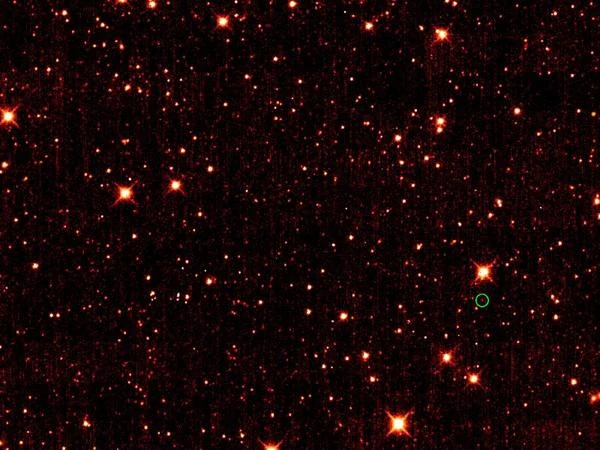
Did you know that Earth is not alone in its orbit? Trojan asteroids, true cosmic companions, discreetly share our path around the Sun.
The Lagrange points \(L_4\) and \(L_5\) of the Earth-Sun system are positions of gravitational equilibrium located 60° ahead and behind Earth (~150 million km) in its orbit. Theoretically stable for small perturbations, these points form potential wells where small celestial bodies, the Trojan asteroids, can reside.
From the perspective of Earth and the Sun, these points keep the asteroids in place through a subtle balance between gravity and centrifugal force, making these points stationary for a small body. These equilibrium points are not fixed locations in absolute space but move in orbital synchrony with Earth around the Sun. They thus provide a privileged site to host asteroids in a semi-stable manner for several thousand years.
It was only in the 21st century that the first Earth Trojans were detected there, due to major observational constraints: the points \(L_4\) and \(L_5\) are close to the Sun in the Earth's sky, making their observation difficult with ground-based instruments. One must scan the sky at twilight or dawn, under unfavorable lighting conditions. These zones must have hosted many objects temporarily captured by planetary perturbations.
The term "Trojan" comes from a naming convention introduced in the early 20th century, following the discovery of asteroids sharing the orbit of Jupiter. In 1906, the asteroid Achilles was identified near Jupiter's Lagrange point \(L_4\). By tradition, objects located at \(L_4\) were named after Greek heroes (Achilles, Ulysses...), while those at \(L_5\) received names from the Trojan camp (Hector, Priam...).
Since then, the term "Trojan" has generally referred to any small body orbiting around the Lagrange points \(L_4\) or \(L_5\) of a planet. Thus, we speak of Jupiter Trojans, Mars Trojans, Neptune Trojans... and now Earth Trojans.
This designation is therefore historical and dynamic, with no direct relation to the city of Troy, but derived from the stable equilateral triangle structure of the Lagrange points, as revealed by celestial mechanics.
Trojan asteroids are celestial bodies gravitationally trapped around the Lagrange points \(L_4\) and \(L_5\) of a planet. In the solar system, Jupiter has thousands of them, but Earth has only a few confirmed so far.
Their dynamics are explained within the framework of the restricted three-body problem, where the third body (the asteroid) has negligible mass. It is trapped around the points \(L_4\) and \(L_5\) when the centrifugal force exactly balances the combined attraction of the Sun and Earth.
The first Earth Trojan (2010 TK7) almost went unnoticed: it was spotted through retrospective analysis of data from the WISE space telescope! Discovered in 2010, 2010 TK7 is the first identified Earth Trojan. It also follows an orbit around the point \(L_4\), but with a much steeper inclination (nearly 21°), making its dynamics more chaotic and its stability shorter.
Its trajectory forms a complex "bean"-like shape in a rotating reference frame, oscillating around \(L_4\) over several millennia. Although its size is modest (~300 m), its discovery paved the way for a new class of co-orbital objects.
| Parameter | Value | Unit |
|---|---|---|
| Semi-major axis | 1.00037 | AU |
| Eccentricity | 0.190 | - |
| Inclination | 20.9 | ° |
| Estimated diameter | 0.3 | km |
| Lagrange Point | L₄ | - |
| Orbital stability | ~10,000 | years |
Sources: NASA WISE (2011), Connors et al., Nature (2011)
The asteroid 2020 XL5, discovered by the Pan-STARRS telescope in 2020, is the largest and most stable of the known Earth Trojans. It orbits around the Lagrange point \(L_4\), 60° ahead of Earth, in an inclined and moderately eccentric orbit.
Dynamic simulations show that its trajectory is stable for about 4,000 years, after which it could leave the co-orbital region. With an estimated diameter of 1.2 km, it could represent a potential target for a space mission.
| Parameter | Value | Unit |
|---|---|---|
| Semi-major axis | 1.00021 | AU |
| Eccentricity | 0.514 | - |
| Inclination | 13.8 | ° |
| Estimated diameter | 1.18 | km |
| Lagrange Point | L₄ | - |
| Orbital stability | ~4,000 | years |
Sources: NASA/JPL (2023), C. de la Fuente Marcos et al. (2022)
| Name | Semi-major axis (AU) | Eccentricity | Inclination (°) | Lagrange Point | Estimated diameter (m) | Orbital stability | Reference |
|---|---|---|---|---|---|---|---|
| 2020 XL5 | 1.00021 | 0.514 | 13.8 | L₄ | 1180 | ~4,000 years | NASA JPL SBDB (2023) |
| 2010 TK7 | 1.00037 | 0.190 | 20.9 | L₄ | 300 | ~10,000 years | WISE/NASA (2011) |
| 2015 XX₁₆₉ | 0.9999 | 0.180 | 8.5 | L₅ (quasi) | — | ~1,000 years | Morais & Morbidelli (2006) |
| 2010 SO₁₆ | 1.0001 | 0.075 | 14.5 | L₄ (quasi) | — | ~350,000 years | Christou & Asher (2011) |
| 2023 FW₁₃ | 1.002 | 0.21 | 13.0 | L₄ (provisional) | — | To be confirmed | JPL Horizons (2024) |
Sources: JPL Horizons (2024), Morais & Morbidelli (2006), Christou & Asher (2011)